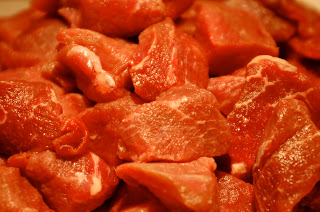 |
| Chickens forced to live on top of each other in dirty conditions for their entire lives |
CAFOs (a.k.a. factory farmed) is an acronym for Concentrated Animal Feeding Operations. Let's explore it more, in detail, with a Q & A format:
Q: What qualifies a farm as a CAFO?
A: The Environmental Protection Agency (EPA) defines a
CAFO as "new and existing operations which stable or confine and feed or maintain for a total of 45 days or more in any 12-month period more than the number of animals specified" in categories that they list out. In addition, "there's
no grass or other vegetation in the confinement area during the normal growing season."
 |
| Cows in a CAFO |
Q: What exactly goes on in a CAFO?
A: Unnaturally large numbers of animals are reared and confined closely together. Cattle feedlots generally contain thousands of animals in one place, while many egg-laying businesses house one million or more chickens. Also:
- Metal buildings confine animals indoors, with minimal room for normal behaviors and little or no access to sunlight and fresh air.
- Animals are mutilated to adapt them to factory farm conditions. This includes cutting off the beaks of chickens and turkeys (de-beaking), and amputating the tails of cows and pigs (docking) and teeth pulling which can send these animals into shock then death.
- Pens and cages restrict the natural behavior and movement of animals. In some cases, such as veal calves and mothering pigs, the animals can’t even turn around.
- Chicken processors kill about 5,000 chickens per hour and are forced to disregard hygiene because of lack of time and often just return bodies dropped on the floor to the processing line.
- Thousands of turkeys are crammed into filthy sheds after their beaks and toes are burned off with a hot blade. Many are still conscious when they are plunged into the scalding water of the de-feathering or hair-removal tanks. This degrades the quality of their meat.
- Cattle and cows are disbudded. Disbudding is destroying the buds on top of the heads of dairy and beef calves and young goats to prevent the growth of their horns – usually done with a hot iron.
Q: Why would a farmer choose to raise his (chickens, pigs, cows, etc.) animals in a CAFO?
A: To produce as much meat, eggs, or milk at the lowest possible cost, thereby creating a more substantial income for the farmer
 |
| Pigs in a CAFO |
Q: What is the environment like in a typical CAFO?
A: Not much better than these scenarios: *
Shame on Smithfield Farms
AND
Shame on Perdue *WARNING- very graphic videos
Q: Are meats, dairy, eggs and other bi-products of CAFO reared animals unhealthy for us to consume?
A: You be the judge:
*The force-feeding of cattle corn, GMO corn and GMO soy cause the cattle to experience acidosis within 180 days. Corn-fed cattle are also prone to serious health conditions such as bloat, diarrhea, ulcers, liver disease, abscesses and a weak immune system.
*Most independent scientists and researchers agree that a grass-fed diet would eliminate 80% of the E. coli in the cow’s digestive tracts. Feeding cattle corn causes E. coli. The problem is so severe that fast food chains like McDonald’s buy hamburger containing ammonia to stop the spread of E. coli from sick animals. (I recently heard McDonald's is going to stop this practice, supposedly, but I wonder what they will use instead of ammonia?)
* Grass-fed beef is significantly higher in calcium, magnesium, beta-carotene, omega-3 and potassium than corn-fed beef. Corn-fed cattle have been found to contain only 15 to 50% as much omega-3 as meat from grass-fed cattle. Grass-fed beef is also four times higher in vitamin E and lower in polyunsaturated fats. Corn-fed cattle are high in bad omega-6 which leads to cancer and heart disease.Current research tells us that Omega-6 fatty acids are the cause of many of our Western diseases, including cardiovascular disease, cancer, inflammatory and autoimmune diseases.
*Almost 10 billion chickens, turkeys and ducks are slaughtered under even worse conditions than cattle each year for their meat. Then, Tyson Foods for example, pump up their chickens with salt brine containing MSG to make them plumper and taste better.
 |
| CAFO impacts on our environment in several ways |
Q: How does a CAFO impact our environment negatively?
A: Mismanagement of waste can do harm in these ways, to name just a few:
 |
| CAFO "lagoon" |
 |
| Sludge created by CAFOs |
- Excessive waste created by large concentrations of animals is handled in ways that can pollute air and water. Here is one example: Concrete floors and damp conditions often lead to laminitis or hoof disease causing of lameness in cattle requiring spraying the cattle with antibacterials. Laminitis leads to inflammation and infections requiring more antibiotics and in many cases, Formalin and Cu sulphate, which are toxic to humans and water.
- Excess nitrates, heavy metals (zinc, copper, arsenic, nickel, manganese, and selenium) and other contaminants also pose a risk to humans, wildlife and migratory birds. Factory farms harm about 20% of endangered and threatened species.
- Man-made lagoons on industrial farms hold millions of gallons of liquid waste, from which contaminants can leach into groundwater. The manure is normally sprayed on crops, but often excessively, leading it to run off into surface waters.
- Nutrients and bacteria from waste can contaminate waterways, killing fish and shellfish and disturbing aquatic ecosystems.
- And one very important result: The loss of more than two-thirds of our Nation’s top soil. There is no crop rotation as a result of the use of GMO Bt corn as feed. Most independent scientists, researchers and traditional farmers assert that the erosion of top soil will have catastrophic effects on our farms and ability to grow food in the future. However, Monsanto uses its IP rights to control who tests their biotech products and to squash any negative research and studies by independent farmers and researchers.
Q: About how many CAFOs are there in the US?
A: I could not find an up to date, true statistic, however I have read up to 99% is estimated. I would bet that the majority of our dairy, meat, eggs, and poultry do indeed come from CAFOs, unfortunately.
Q: What are some companies who buy their meat from CAFOs?
A: Tyson, Perdue and Smithfield to name a few top producers. And, don't forget the big chain franchises (McDonald's, KFC, Taco Bell, etc....) How else is McDonald's the biggest buyer/seller of beef? It's not by buying farm ranched cattle and farm raised chickens. I saw the recent commercial the McDonald's has put out with a real "Cowboy" at his ranch. He may be ONE of the producers of McDonald's beef, but he certainly cannot be the only one. I'd love a tour of his ranch to see how his cattle are reared.
 |
Humanely raised, happy chickens
|
Q: But what about Perdue's labeling and advertising stating that their chickens are fed an all vegetarian diet, cage free, as well as being hormone and anti-biotic free?
A: It is against the law to administer hormones to chickens and it has been for over 50 years. So, that's just tooting a horn for no reason, really. The vegetarian diet Perdue boasts about is made up of corn, soy beans, and marigolds. The corn and soy beans are highly likely from GMO seeds. Marigolds are fed to the chickens to add color to their meat (no wonder it has a yellow-orange hue sometimes!), but I will not argue that feeding marigolds to the chickens is a bad thing. Organically grown marigolds would be ideal, but I can guarantee these chickens would not be eating organically certified anything or Perdue would be certain to put that on their label too. Regarding cage free, I am sure they are not confined to cages, however, it is quite a broad claim as Perdue states: "
We are committed to creating safe living conditions for our chickens and ensure that they have free access to food and water. By raising our chickens inside,
we can ensure that they are protected from the elements, predators and disease. They are
not confined or raised in cages." END QUOTE.
| So, the chickens are raised inside buildings, likely crowded together (not unlike a CAFO), in unnatural surroundings. I think it's sad that Perdue feels they can trick Americans with their advertising and marketing schemes. |
 |
| Notice the corn, Perdue's main "vegetarian feed" and what is "Process Verified" anyway?????? |
Q: What should I be looking for when buying dairy, eggs, poultry and meats?
A: Look for pasture and humanely raised, free range, grass fed (and ideally grass or green finished), organic, no hormones or anti-biotics, and preferably local farms. Most major grocers carry at least organic options and some go even a step further with the pasture raised on organic greens on small, happy farms. Your health food stores should have even better options.
 |
| Humanely raised, happy cattle |
Q: What can I do to limit eating meats, dairy, eggs, and poultry that originate from a CAFO?
A: The best way, if you have the resources, is to buy local. Do an online search in your area for local beef and dairy farmers, chicken and egg farmers, etc. Go visit their farm, see how they rear their animals and what the conditions are like. If you cannot do this but you are able to purchase on line, there are many great farms that are now providing their meats, cheeses, and more, to be shipped directly to you (including
Beyond Organic, here). Then, as mentioned previously, try your major grocer or health food stores.



























































